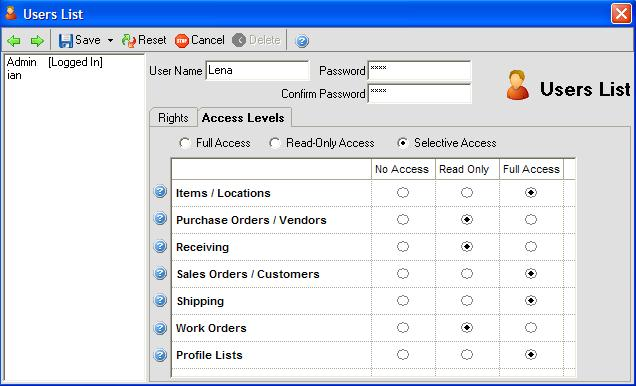April 27, 2016 at 1:45 PM
—
Thomas Riemann
Happy day to everyone!
The Manage Users command, available from the Company menu, allows you to set access levels for every individual in your organization who will be accessing the All Orders system, including sales, administration, production teams, etc. This must be done separately within All Orders, as the application does not make use of QuickBooks user profiles.
By default, only the Admin account exists. This account does not initially have a password. If you're going to be setting up a multi-user environment, then this is the first thing you'll want to remedy. Administrators have complete access to the program and its data, and only administrators can view, add, edit, or delete users and user rights. As such, this account needs to be well-protected with a strong password. Type a password into the Password field, and then retype it in the Confirm Password field.
Once you've protected your Admin account, it's time to add other users. Choose Save & New from the Save drop-down list button. You'll then be required to choose a User Name and Password as well as set access privileges.
After entering the unique user name and password, click the Access Levels tab.

On this screen you can assign access levels to various parts of the program as follows:
-
No Access. User cannot edit or even read the list.
-
Read-Only Access. User can access the data, but cannot make edits.
-
Full-Access. User can access the data and has full write privileges for making edits.
Then click the Rights tab and complete the user rights:
-
This user is connected to QuickBooks option appropriately. Unchecking this option disables synchronization with QuickBooks. See Synchronizing with QuickBooks on different strategies for QuickBooks exchanging information with QuickBooks.
-
There are numerous check boxes that can be used to grant/restrict access to the user in question, such as the ability to delete records or approve Sales Orders. Check all the boxes that apply.
-
In addition to these check boxes, All Orders also sports two special filters: by Sales Rep, and by Location. For example, if you want to restrict an employee's data access to a customers having a particular sales rep.
-
Choose either Save & Close to save your work and exit the dialog, or Save & New to save the current user and move on to the next one.
Well that is all for today! I hope everyone has a great weekend! Make sure to contact us if you have and Questions. support@numbercruncher.com or call us @ 866-278-6243.
e51d239c-fc97-4758-a033-bc0820959b05|0|.0
Posted in:
Tags: All Order MobileAll Orders, All Orders, numbercruncher, outsource, QuickBooks, production, receiving, small business, software inventory management, tracking, solutions, warehouse, pick list
May 20, 2015 at 11:33 AM
—
Rachel
It is widely understood that having a proper and concise system for creating and filling sales orders is crucial for proper allocation of resources to complete a sale. Need more reasons on why you need to get a handle on your sales orders? Check out our post about why you need a sales order here. Now, the question is how can NumberCruncher change the way you approach your sales orders?
With All Orders, the sales order process is dynamic and seamlessly integrated with QuickBooks. All Orders allows the user to create sales orders with multiple shipping and release dates, thus eliminating the need for multiple sales orders. A single sales order can support multiple ship-to addresses as well as items considered to be inventory and non-inventory. Features like this allow the user to create a single sales order that meets a variety of needs.
Is an item running low or out of stock? The sales order screen includes information about the availability of items in the order. If stocks need to be refilled, purchase orders can be created in seconds. This new purchase order is linked to the sales order and items are held for matched the sales order as they are received by the warehouse. Once the purchase order is received, the underlying sales order can be satisfied automatically. No need to check back and forth on an purchase order to know when to update the SO. Upon filling a sales order, All Orders creates a ‘shipper’, from here an invoice is created in QuickBooks with the click of button.
If a user is transitioning to All Orders after using QuickBooks for their sales orders, the transition is simple. Existing sales orders can be imported directly into All Orders from QuickBooks. The linked sales, work, and purchase orders as well as the integrated pick lists and ship docs are designed to reduce errors and improve efficiency.
All Orders by NumberCruncher provides solutions for your inventory and order management needs. For more information or to request a free trial, visit our website.